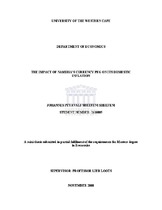| dc.description.abstract | This study analyses the impact of Namibia’s currency peg on its domestic inflation. This is because theoretical argument suggests that currency peg (fixed exchange rate) provides nominal anchor for domestic price level, in particular when the domestic currency is pegged to a stable foreign currency. Following the method of hypothesis testing, data on Namibia and South Africa are used in this regard. Three main findings emerged from this study. Firstly, it was shown that the two inflation rates are positively correlated.Secondly, the study shows that there is no statistical significance difference between the inflation rates of the two countries. This gives an indication that the currency peg served as a nominal anchor, because as the SA inflation rate came down, so did the Namibian inflation rate. Thirdly, the study also shows that the growth of money stock in Namibia does not deviate from the growth of money stock in SA. This gives an indication that the authorities have maintained the peg through control of monetary growth. | en_US |

